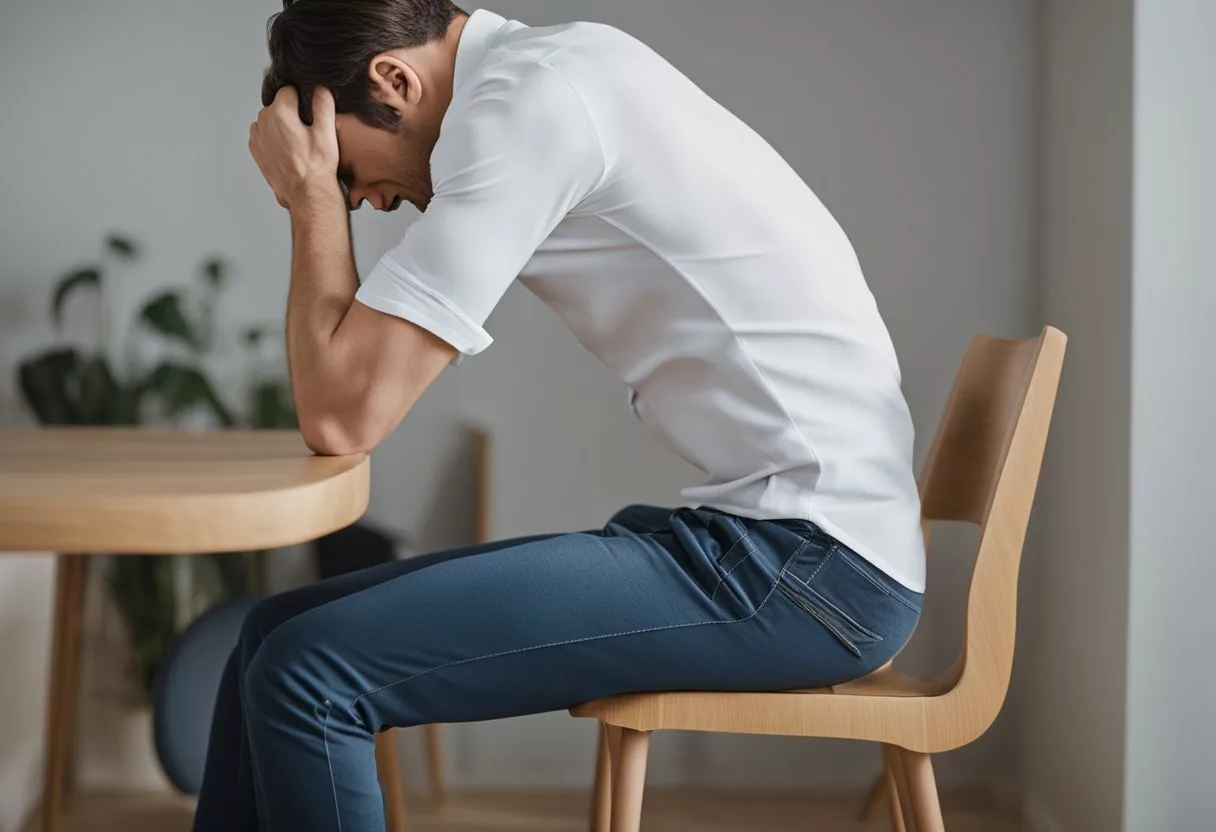A sudden twinge in your lower back can stop you in your tracks. This common problem is often called “throwing out your back.” It happens when you strain or injure the muscles or ligaments in your lower back.

Throwing out your back typically causes sharp pain, muscle spasms, and stiffness in the lower back area. The pain can make it hard to move or stand up straight. Many people feel a pop or hear a sound when it happens.
Most cases of thrown-out backs get better with rest and home care. Ice packs, gentle stretches, and over-the-counter pain medicine can help ease the discomfort. But some cases may need medical attention. Knowing when to see a doctor is key to proper treatment and recovery.
Key Takeaways
- A thrown-out back causes sudden pain and stiffness in the lower back
- Rest, ice, and gentle stretches can help ease symptoms at home
- See a doctor if pain is severe or lasts more than a few days
Understanding ‘Throwing Out Your Back’
Throwing your back out is a common phrase for sudden lower back pain. It often happens due to muscle strain or injury to the spine’s structures.
Definition and Causes
Throwing out your back means a sudden onset of lower back pain. It usually occurs from an awkward movement or lifting something heavy. Common causes include:
- Bending incorrectly
- Twisting while lifting
- Poor posture
- Weak core muscles
This pain can result from muscle strain, ligament sprain, or a problem with the spinal discs. The pain may be sharp and severe, often causing muscle spasms.
People with existing back issues or poor physical fitness are more likely to experience this problem. Proper lifting techniques and regular exercise can help prevent it.
Anatomy of the Lower Back
The lower back is a complex structure of bones, muscles, and connective tissues. Key components include:
- Vertebrae: The bones that make up the spinal column
- Discs: Cushions between vertebrae that absorb shock
- Ligaments: Tough bands that hold bones together
- Muscles: Provide support and allow movement
When someone throws out their back, one or more of these parts may be affected. For example, a muscle might be strained or a disc might bulge.
The lower back bears much of the body’s weight. This makes it prone to injury, especially during sudden movements or when lifting heavy objects.
Symptoms and Diagnosis

When you throw your back out, you may feel intense pain and limited mobility. Knowing the signs and getting proper medical care is key for recovery.
Recognizing Symptoms
Throwing out your back often causes sharp, shooting lower back pain. You might feel aching muscles and stiffness that limits movement. Some people have trouble standing up straight.
Muscle spasms can occur, making the back tighten and relax rapidly. The pain may spread to your legs. In some cases, you might feel numbness or tingling.
Other symptoms can include:
- Difficulty bending or twisting
- Pain that gets worse with movement
- Trouble getting out of bed
If you have a fever with back pain, it could point to a more serious issue.
Seeking Medical Attention
See a doctor if your back pain is severe or lasts more than a few days. A primary care provider, physical therapist, or chiropractor can help.
The doctor will do a physical exam. They’ll check your range of motion and look for signs of nerve problems. They might ask about your medical history and how the injury happened.
In some cases, the doctor may order tests:
- X-rays to check for bone problems
- CT scans or MRIs for a detailed look at soft tissues
These tests help rule out serious issues and guide treatment. The right diagnosis ensures you get the best care for your thrown-out back.
Immediate Actions and Pain Relief
When you throw your back out, quick action can help ease pain and prevent further injury. The right mix of rest, medication, and other treatments can provide relief.
First Aid for a Thrown Out Back
Rest is key when you first hurt your back. Lie down on a firm surface with your knees bent and a pillow under them. This takes pressure off your spine. Use ice packs for the first 48 hours to reduce swelling. Apply cold for 15-20 minutes at a time.
After two days, switch to heat. Warm compresses or a heating pad can relax tight muscles. Limit bed rest to 1-2 days. Too much rest can weaken muscles and slow healing.
Gentle movement helps once the pain eases. Short walks or light stretches can improve blood flow and flexibility. Don’t push too hard or do activities that cause pain.
Pharmacological Options
Over-the-counter pain relievers can help manage discomfort. Acetaminophen (Tylenol) reduces pain without affecting inflammation. It’s gentler on the stomach than other options.
Nonsteroidal anti-inflammatory drugs (NSAIDs) like ibuprofen (Advil) or naproxen (Aleve) fight both pain and swelling. They may work better for some people but can cause stomach upset.
For severe pain, a doctor might prescribe stronger meds. Muscle relaxants can ease spasms. Steroid injections may help in some cases. These reduce inflammation around irritated nerves.
Always follow dosage instructions. Talk to a doctor before taking new medications, especially if you have other health conditions or take other drugs.
Non-Pharmacological Therapies
When you throw your back out, several non-drug treatments can help ease pain and promote healing. These approaches focus on improving mobility, strengthening muscles, and reducing discomfort without medication.
Physical Therapy and Exercise
Physical therapy plays a key role in recovery from a thrown out back. A therapist can teach specific exercises to strengthen core muscles and improve flexibility. These exercises often include gentle stretches and movements to increase range of motion.
Therapeutic exercises target the affected area and surrounding muscles. They help restore function and prevent future injuries. A typical routine might include:
- Gentle back stretches
- Core strengthening exercises
- Low-impact aerobic activities like walking or swimming
Gradually increasing physical activity is important. It helps maintain strength and flexibility while promoting healing. Yoga and tai chi are also beneficial. They combine stretching, strengthening, and relaxation techniques.
Alternative Treatments
Alternative therapies can complement traditional treatments for a thrown out back. Massage therapy is a popular option. It can help relax tense muscles and improve blood flow to the affected area.
Acupuncture is another alternative treatment some people find helpful. It involves inserting thin needles into specific points on the body. This may help reduce pain and promote healing.
Chiropractic care focuses on spinal manipulation. A chiropractor can adjust the spine to improve alignment and reduce pain. However, it’s important to consult a doctor before trying chiropractic treatment for a thrown out back.
Heat and cold therapy can also provide relief. Applying ice packs can reduce inflammation in the first 48 hours. After that, heat can help relax muscles and increase blood flow.
Prevention and Long-Term Care
Taking steps to protect your back can help avoid future injuries. Good habits and regular care make a big difference in back health over time.
Adopting Good Body Mechanics
Good body mechanics are key to preventing back injuries. When lifting heavy objects, bend at the knees and keep the back straight. Hold items close to the body.
Avoid twisting motions while carrying weight. Instead, pivot with the feet to turn. Use proper posture when sitting or standing for long periods. Keep the spine aligned and shoulders back.
At work, adjust desk and chair height for comfort. Take regular breaks to stretch and move around. Using back support cushions can help maintain good posture throughout the day.
Maintaining Physical Health
Regular exercise strengthens back and core muscles. This provides better support for the spine. Aim for 30 minutes of activity most days. Low-impact options like swimming or walking are great for the back.
Stretching improves flexibility and range of motion. Yoga and pilates can enhance core strength and stability. Maintaining a healthy weight reduces strain on the back.
Getting enough sleep allows the body to repair itself. Use a supportive mattress and pillow. Stay hydrated by drinking plenty of water each day. A balanced diet rich in calcium and vitamin D supports bone health.
When to Consider Surgery

Surgery is rarely the first option for back pain. It’s only considered when other treatments fail and symptoms are severe.
Assessing the Need for Surgical Intervention
Doctors may suggest surgery for chronic low back pain when conservative treatments don’t work. These treatments often include physical therapy, medication, and lifestyle changes.
Surgery might be necessary for a herniated disc that causes ongoing nerve pain. This can lead to weakness or numbness in the legs.
Spinal issues like spinal stenosis or spondylolisthesis may also require surgery. These conditions can cause severe pain and limit mobility.
Doctors use imaging tests to confirm the need for surgery. These may include X-rays, MRIs, or CT scans. They also consider the patient’s overall health and ability to recover from surgery.
It’s important to discuss the risks and benefits of surgery with a doctor. They can help patients make an informed decision about their treatment options.
Support and Recovery
Getting better after throwing out your back takes time and care. Having support from others can help make the process easier.
Recovery Timeline and Expectations
Most acute low back pain gets better in a few days to weeks. Mild cases may improve in 2-3 days. More severe injuries can take 4-6 weeks.
The healing process happens in stages:
- Days 1-3: Rest and manage pain
- Days 4-7: Gentle movement
- Weeks 2-4: Gradual return to activities
Full recovery depends on the injury. Some people feel better quickly. Others need more time. It’s important to be patient and not rush back to normal activities too soon.
Support Systems and Coping
Having support makes a big difference in recovery. Family and friends can help with daily tasks and give emotional support. Some find counseling helpful for dealing with ongoing pain.
Pain management options include:
- Ice/heat therapy
- Over-the-counter pain relievers
- Gentle stretches
- Massage
Staying positive aids healing. Setting small goals each day gives a sense of progress. Relaxation techniques like deep breathing can ease stress and discomfort.
Joining a support group lets people share tips and feel less alone. Online forums provide 24/7 connection with others going through similar experiences.
Frequently Asked Questions

Back injuries can be painful and disruptive. Learning about warning signs, proper care, and prevention methods is crucial for maintaining back health. Here are some common questions people have about throwing out their back.
What are the indications that your back may be close to injury?
Warning signs of potential back injury include muscle stiffness and tightness. Dull aches or sharp pains in the lower back area can also signal trouble. Sudden movements or changes in posture may cause discomfort or pain.
What steps should you take if you’re unable to move due to back pain?
If severe back pain prevents movement, stay calm and avoid further strain. Apply ice to the affected area for 20 minutes at a time. Take over-the-counter pain medication if needed. If pain persists or worsens, contact a healthcare provider for guidance.
What is the best way to sit after sustaining a back injury?
When sitting with a back injury, maintain good posture. Keep your feet flat on the floor and your back straight. Use a small pillow or rolled towel for lumbar support. Avoid sitting for long periods and take regular breaks to stand and stretch.
What is the typical recovery duration after throwing out your back?
Recovery time varies depending on the severity of the injury. Mild strains may improve within a few days, while more serious injuries can take several weeks. Most people recover within 2-4 weeks with proper rest and care.
Which exercises can help in the prevention of back injuries?
Strengthening core muscles helps prevent back injuries. Try gentle exercises like pelvic tilts and bridges. Stretching exercises for the back and hamstrings improve flexibility. Low-impact activities like swimming and walking can also boost back health.
What are the treatment options for a back that has been severely strained?
For severe back strains, rest is crucial in the first 24-48 hours. Apply ice and heat alternately. Over-the-counter pain relievers can help manage pain. Physical therapy may be recommended for exercises and manual treatments. In some cases, a doctor may prescribe muscle relaxants or stronger pain medication.